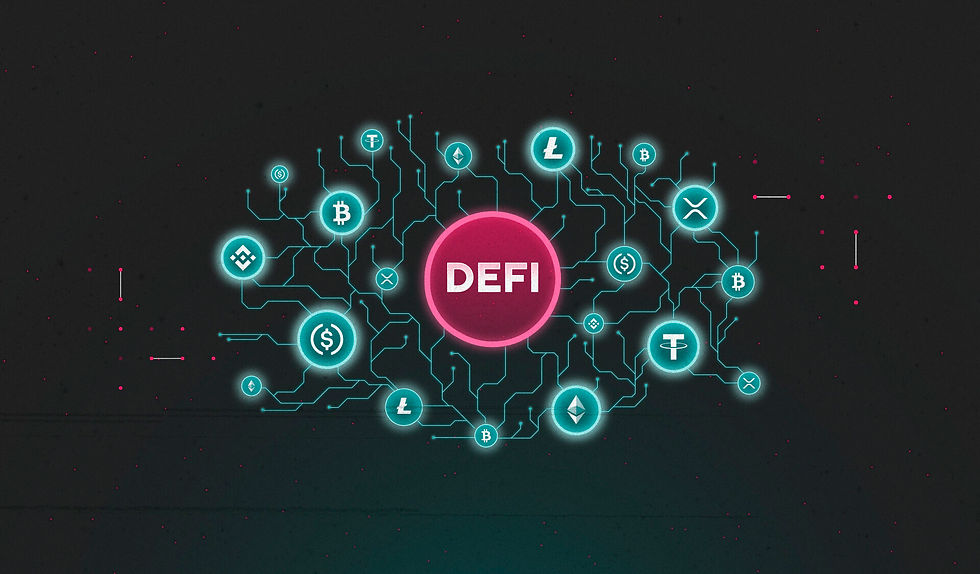The Beginner’s Guide to Using DeFi Without Getting Hacked
- Bitcoinsguide.org

- Jun 11
- 3 min read
Learn how to safely explore decentralized finance (DeFi) without falling victim to scams, hacks, or wallet-draining mistakes.
Introduction
Decentralized Finance (DeFi) opens a world of financial freedom—staking, swapping, lending, and yield farming without intermediaries.
But with that freedom comes risk. In 2025, billions have been lost to scams, smart contract exploits, and simple user errors.
This beginner’s guide will teach you how to navigate DeFi securely, avoid common pitfalls, and use on-chain tools with confidence.
Whether you’re a newcomer or just looking to level up your safety game, read on.

🔒 1. Use a Hardware Wallet (Not Just MetaMask)
Software wallets like MetaMask are convenient but vulnerable—especially if your browser or device is compromised.
Solution:Use a hardware wallet (Ledger, Trezor) for any significant amount of crypto. This adds a physical confirmation layer to every transaction.
Even if you click a malicious link, funds can't leave without your device’s approval.
🛑 2. Never Sign Unknown Smart Contract Requests
When interacting with dApps, you’ll be asked to “sign” things.
Some are harmless (login messages), others can give unlimited token access or drain wallets.
Rule of thumb:
Read every prompt carefully.
Reject anything you don’t understand.
Use tools like Revokecash to review and revoke token approvals.
🧠 3. Stick to Audited & Established Protocols (at First)
DeFi is full of experimental projects. While the upside can be massive, so is the risk.
Start with these:
Lending: Aave, Compound
Swaps: Uniswap, Curve
Staking: Lido, Rocket Pool
Aggregators: Yearn, Beefy
Always check for audits, TVL (total value locked), and community reputation.
🔍 4. Verify dApp URLs and Smart Contracts
Phishing websites are a major attack vector in DeFi. One typo and you’re on a fake version of a dApp.
Best practices:
Bookmark official links (e.g., uniswap.org).
Double-check contract addresses on CoinGecko or DeFiLlama.
Use ENS (.eth) links where available.
🧰 5. Use Read-Only Wallet Tools to Simulate Transactions
Tools like Rabby, Tenderly, or DeBank let you preview what a smart contract will do before you sign.
Some wallets (like Rabby) even simulate the result of the transaction and warn you if it’s suspicious.
⚠️ 6. Watch Out for Fake Airdrops and "Dusting" Attacks
Getting tokens you didn’t request in your wallet? Could be bait.
Interacting with malicious tokens can lead to wallet compromise.
Don’t:
Approve or swap mystery tokens.
Click unknown token links in block explorers.
Use Etherscan’s token ignore list or hide them in your wallet.
🔄 7. Revoke Token Approvals Regularly
Over time, you may grant dozens of dApps access to your wallet. Some of these could be compromised.
Solution:
Use Revoke.cash or Etherscan to remove unused permissions.
Think of it as offboarding apps you no longer use.

🛡️ 8. Use DeFi Insurance (Optional but Smart)
Platforms like Nexus Mutual or InsurAce offer insurance on smart contracts, stablecoins, or exchanges.
If you’re putting significant capital in a DeFi protocol, consider insuring it—especially during early adoption phases.
✅ 9. Practice with Small Amounts First
Before jumping into yield farming or bridging, test the process with a small amount. Learn how to use the UI, monitor gas fees, and understand the flow.
Tip:If something feels sketchy—it probably is. Trust your gut and research before clicking.
Final Thoughts
DeFi is powerful—but it’s not foolproof.
The same tools that let you earn, lend, or swap without banks also put you in charge of your own security.
By staying cautious, verifying every interaction, and using the right tools, you can enjoy the upside of DeFi while minimizing the risk.
Crypto rewards the informed—not the impulsive.
🟩 Want more beginner-friendly crypto guides?
Subscribe to BitcoinsGuide.org for weekly tutorials, insights, and tools to help you grow in Web3—safely.



Comments